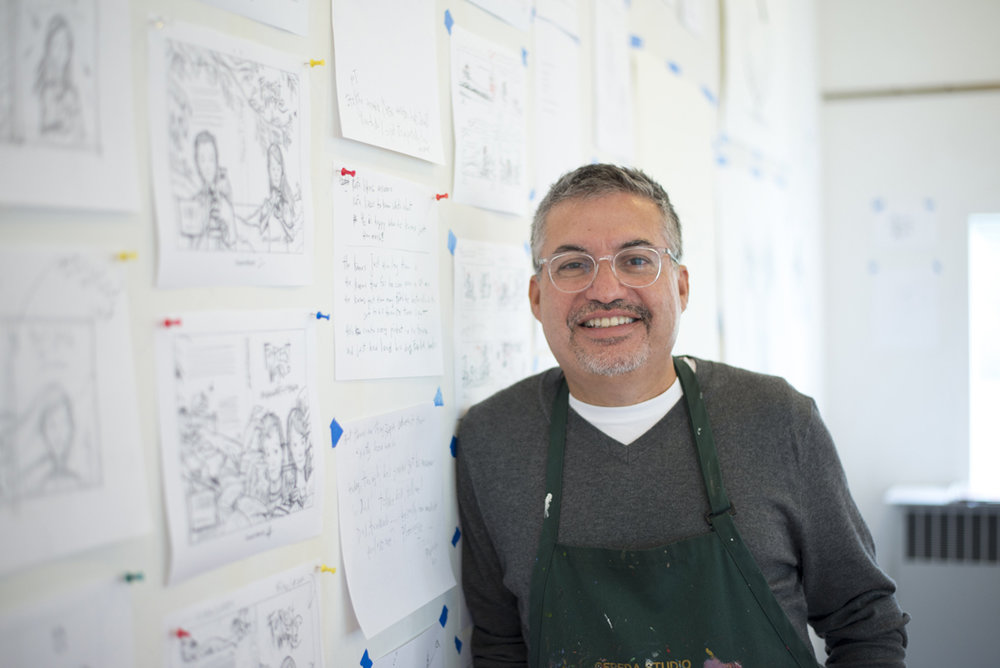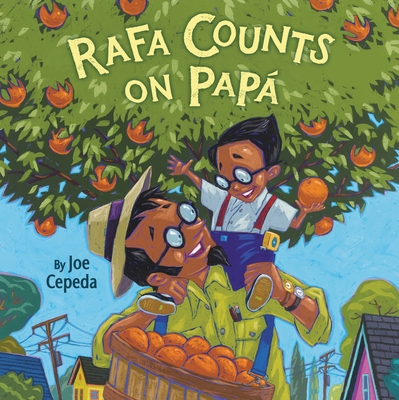By Judi Moreillon, Tucson, AZ
 Joe Cepeda participated in the 15th Annual Tucson Festival of Books in March, 2024. He was a panelist for the “Every Word Counts: Authoring a Picturebook” session. It was in that panel presentation that Joe shared his deeply personal connection to his latest author/illustrated book Rafa Counts on Papá.
Joe Cepeda participated in the 15th Annual Tucson Festival of Books in March, 2024. He was a panelist for the “Every Word Counts: Authoring a Picturebook” session. It was in that panel presentation that Joe shared his deeply personal connection to his latest author/illustrated book Rafa Counts on Papá.
Joe is an an award-winning children’s book illustrator. He earned the Pura Belpré Illustrator Honor Award for Juan Bobo Goes to Work written by Marisa Montes. He has illustrated more than forty books, including Side by Side: The Story of Dolores Huerta and César Chávez / Lado A Lado: La historia de Dolores Huerta y César Chávez written by Monica Brown and Mice and Beans by Pam Muños Ryan. Joe has also illustrated book jackets for award-winning titles such as Merci Suarez Changes Gears written by Meg Medina, which earned the Newbery Medal.
Recently, Joe has been writing as well as illustrating. His first author/illustrated book was The Swing published by Arthur Levine Books in 2006. However, he didn’t author/illustrate another book until Up, which was published by Holiday House in 2016. In 2021, his book I Hop received the 2021 Theodore Geisel Honor award. That book is now part of the “I Like to Read” series published by Holiday House.
Becoming an Author-Illustrator
Question: How did you enter into story writing as well as illustrating?
The very first time I showed my portfolio to an editor, I included a couple images from a story I was trying to write. Even without knowing that, art directors and editors asked me if I wrote. as well as illustrated. My portfolio was made up largely of editorial pieces. I think my training in working as an editorial illustrator tapped into whatever storytelling ability I might have.
The truth is, I got so much work illustrating, I put the story writing part of me to the side for a long time. It remained largely an undeveloped part of my work until the last few years when an editor invited me to write and illustrate a book for an early reader series. I took that as an opportunity to kickstart my writing interest. I was then able to develop a few seeds of story ideas that had been waiting around patiently for a long time.
Creative Process
Question: As a book author, do you “see” the story in pictures first or in words? Please describe your process for author-illustrating and for illustrating someone else’s story.
I think it happens either way depending on the story. If it’s not too silly to say, I write pictures, and I see words. At this point, everything is either a mark, or it’s stimuli. It’s either input or output. I’m pretty good at visually telling a story that’s already written. I have developed that skillset over many years. My challenge at this point in time is in building a story from scratch. Plot and story construction are what I’m working to improve. That’s what’s new to me more than anything. I get help from my critique groups, and certainly rely on editors and my agent when it comes to writing stories.
Rafa Counts on Papá
 Question: Will you tell us about the epiphany you had as you were completing Rafa Counts on Papá? Why was this meaningful to you?
Question: Will you tell us about the epiphany you had as you were completing Rafa Counts on Papá? Why was this meaningful to you?
Rafa Counts on Papá started out as a book about a boy who primarily loves counting and measuring; his dad is like him, too. Rafa eventually wonders if they can count the immeasurable… in particular… love. All the way to the last days of painting the illustrations I largely thought about Rafa and who he was.
As I was finalizing the book, it dawned on me that I had actually painted a story about myself, at least the dad I hoped I was for my son. That is, a dad that creates a place… a safe place for a child to feel they can be whatever they want to be. Rafa’s dad never utters a word in the book; he simply lets his boy be. It threw me for a little bit of a loop on those final days of the project that I had not really made that connection before. The story was about me, too.
Reaching Out in Communities
Question: Why do you visit schools and speak about your life and work?
Firstly, I simply enjoy meeting young people and teachers! Secondly, I feel strongly about young people feeling the power of telling their own story. Every child should feel their story is worth telling. I want children to know that, and, hopefully, I demonstrate that the challenge is to do it beautifully.
New Titles
Question: Is there a forthcoming book you want to spotlight?
I have another father and son book coming out this month. The Best Worst Camp Out Ever is a graphic novel/comic for young readers.
Sumo Libre will be available in early summer. It’s a story about two boys who become friends over their love of wrestling. Friends, that is, until they have a disagreement… and what they do to fix things.
Joe Cepeda received his Bachelor of Fine Arts in illustration from California State University, Long Beach. He lives in southern California where he served as past president of the Society of Illustrators of Los Angles. You can visit Joe Cepeda online at www.joecepeda.com.
Using Joe Cepeda’s Books in the Classroom and Library
Educators, particularly in the elementary grades, often begin the school year with invitations to students to write and draw about their families, friends, pets, summertime experiences or other aspects of their out-of-school lives. As Joe notes, encouraging children to share their own stories is a central goal of his school visits.
A text set that includes Joe’s titles can support student authors and illustrators. The books in the “I Like to Read” series offer story ideas for early primary children. For example, in I See, Joe shows two young brothers using a magnifying glass to explore the natural world outside their home. For older children, family time as portrayed in books like Mice and Beans, Rafa Counts on Papá and The Best Worst Camp Out Ever can inspire students’ personal narrative writing. Including Joe’s forthcoming book Sumo Libre will appeal to aspiring artists who choose to share their stories with illustrations as well as words.
Joe’s books provide reflections of children’s lives that may be similar or different from their own. Many of his titles share aspects of his own Chicano culture. After children write and draw about their own lives, educators will encourage them to share their stories with partners, small groups or the entire class. Sharing helps build community in the classroom or library.
Authors’ Corner is a periodic profile feature in which authors discuss their writing process and the importance of school visits. Worlds of Words frequently hosts these authors for events in the collection. To find out when we are hosting an author, check out our events page. Journey through Worlds of Words during our open reading hours: Monday-Friday, 9 a.m. to 5 p.m. and Saturday, 9 a.m. to 1 p.m.
- Themes: Joe Cepeda, Judi Moreillon, Rafa Counts on Papa
- Descriptors: Authors' Corner
